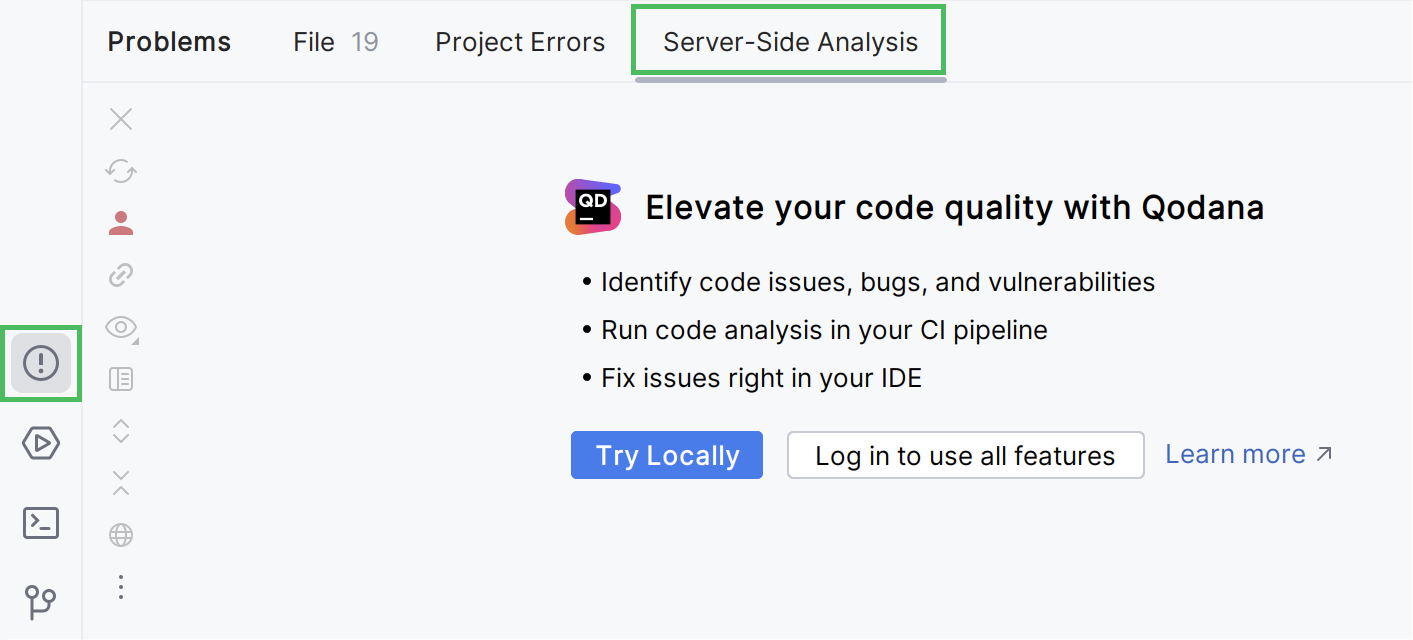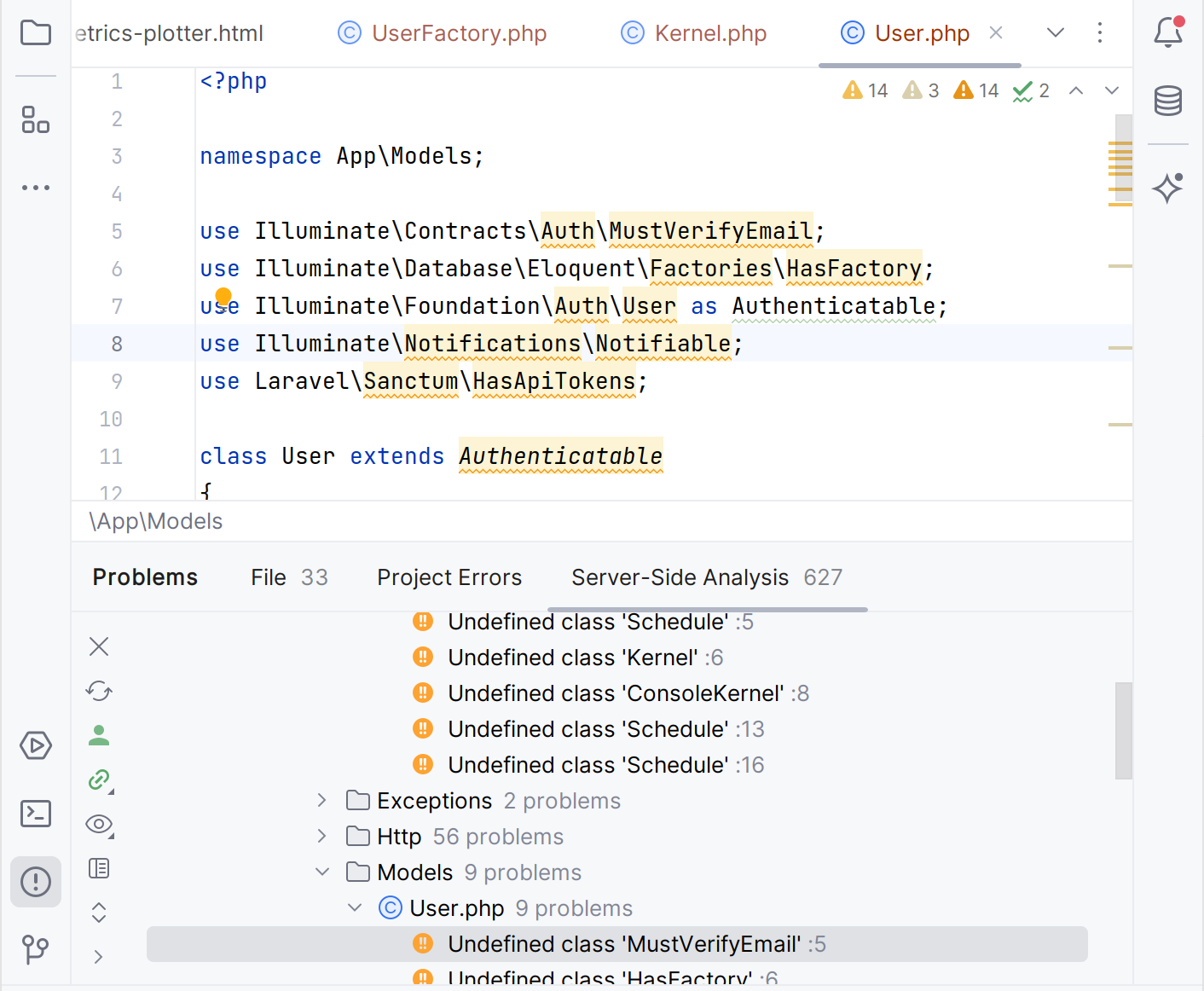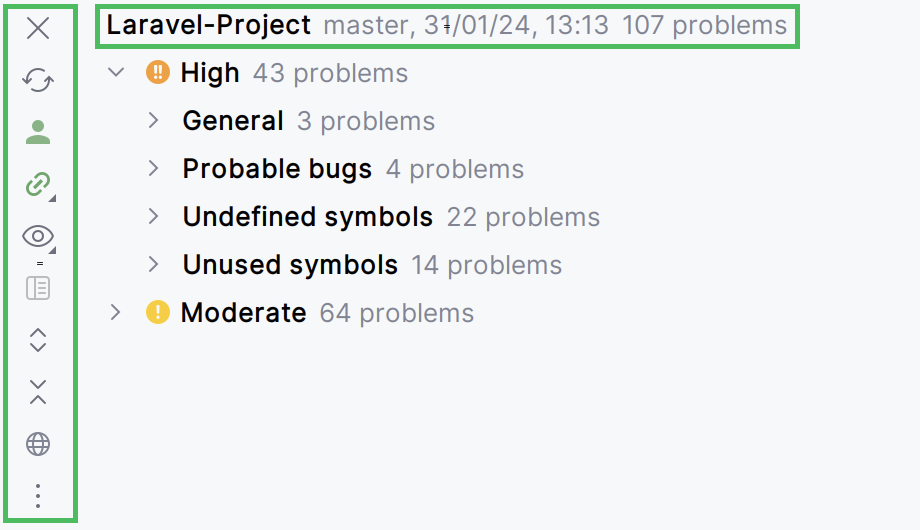JetBrains IDEs
Edit pageLast modified: 16 January 2025You can run Qodana in JetBrains IDEs to inspect your codebase. Qodana supports several JetBrains IDEs installed via JetBrains Toolbox App, such as IntelliJ IDEA, PhpStorm, WebStorm, Rider, GoLand, PyCharm, and Rider.
Using the IDE, you can:
UI overview
In your IDE, navigate to Tools | Qodana.

You can also have access to Qodana using the Problems | Server-Side Analysis tool window of your IDE.

Run Qodana locally
You can run Qodana locally and then forward inspection reports to Qodana Cloud for storage and analysis purposes.
In your IDE, navigate to Tools | Qodana | Try Code Analysis with Qodana.
On the Run Qodana dialog, you can configure:
Options used by Qodana in the
qodana.yamlfileThe Send inspection results to Qodana Cloud option using a project token
The Save qodana.yaml in project root option
The Use Qodana analysis baseline option to run Qodana with a baseline

Click Run for inspecting your code.
On the Server-Side Analysis tab of the Problems tool window, see inspection results.
Connect to Qodana Cloud
You can log in to Qodana Cloud and connect your project opened in the IDE to a specific Qodana Cloud project to get the latest Qodana report and view it.
In your IDE, navigate to Tools | Qodana | Log in to Qodana.
On the Settings dialog, click Log in.

This will redirect you to the authentication page.
Select the Qodana Cloud project to link your local project with.

By enabling the Always load most relevant Qodana report option, you can get actual reports automatically retrieved from Qodana Cloud.

In this case, the IDE will search and fetch from Qodana Cloud the report with the revision ID corresponding to the current revision ID (HEAD). If this report was not found, the IDE will select the previous report with the revision closest to the current revision ID (HEAD). Otherwise, the IDE retrieves the latest available report from Qodana Cloud.
On the Server-Side Analysis tab of the Problems tool window, see inspection results.
Configure Qodana for CI
After logging in to Qodana Cloud, you can configure Qodana in your CI pipelines.
note
Depending on the Qodana license, you will need to generate and use the project token. To learn more about project tokens, see the Project tokens section.
In your IDE, navigate to Tools | Qodana | Add Qodana to CI Pipeline
On the Add Qodana to CI Pipeline dialog, follow the recommendations applicable to your CI/CD solution.

Open a local report
You can open and review SARIF-formatted Qodana reports in your IDE.
In your IDE, navigate to Tools | Qodana | Open Local Report.
Select the SARIF-formatted report file you would like to open.
On the Server-Side Analysis tab of the Problems tool window, you can view inspection results.
Qodana report overview
Using the Server-Side Analysis tab of your IDE, you can view Qodana reports and navigate to the code fragments containing such problems.

The upper part contains information about the project and branch names, the inspection date, and the number of problems. The left part of the Server-Side Analysis tab contains several buttons.

This table describes each button from top to bottom:
Button | Description |
|---|---|
Close Report | Close the report that was previously opened |
Refresh Report | Download the updated version of the report from Qodana Cloud. This requires that you first link your project with Qodana Cloud |
Log in to Qodana / Logged in to Qodana | Log in Qodana Cloud, or log out. This action is a prerequisite for linking your project with Qodana Cloud-based reports |
Link project with Cloud / Linked with Cloud | Link your project with a specific Qodana Cloud-based project, or unlink it. This requires that you first log in to Qodana Cloud |
View Options | Filter out code issues by their severity and configure their sorting. When no grouping or sorting options are selected, the issues are listed in the order they appear in the file. You can also filter all issues by the baseline |
Open Editor Preview | Open the preview pane to view the selected issue in its source context. This preview lets you change the code and apply available quick-fixes |
Expand All | Expand all nodes to see all issues in the expanded form |
Collapse All | Collapse all nodes that were previously expanded |
Show Qodana in Browser | Open the inspection report using your default browser |
Other | Functionalities from the Tools | Qodana menu |
Qodana log overview
In your IDE, navigate to Help | Collect Logs and Diagnostic Data. This will collect all necessary data and save them under a specific directory.
Thanks for your feedback!